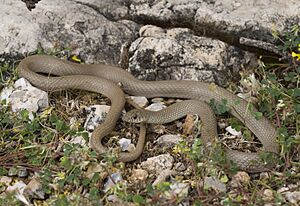Ring-headed dwarf snake facts for kids
Quick facts for kids Eirenis modestus |
|
|---|---|
 |
|
| At Samos, Greece | |
| Conservation status | |
| Scientific classification | |
| Genus: |
Eirenis
|
| Species: |
modestus
|
| Synonyms | |
|
|
The ring-headed dwarf snake (Eirenis modestus) is a type of snake that belongs to the Colubridae family. It is also known simply as the dwarf snake. These snakes live in several Greek islands, Turkey, Syria, Armenia, Azerbaijan, Israel, Lebanon, and parts of southwestern Russia.
Contents
Discover the Dwarf Snake's Appearance
The ring-headed dwarf snake is a very thin snake, like a pencil. It can grow up to 60 centimeters (about 2 feet) long, but most adult snakes are smaller.
Its skin feels smooth. The edges of its scales are a bit darker than the middle parts. The top of its body is usually a plain yellowish-brown, greyish-brown, or reddish-brown color. Its belly is shiny white.
The top of its head has a big black spot. Inside this spot, you might see two whitish dots or a light W-shaped mark. Around its neck, there is a dark band shaped like a crescent moon. A lighter band separates this dark band from its head.
Where Dwarf Snakes Live
The ring-headed dwarf snake is found on several Greek islands in the Mediterranean Sea. These islands include Lesbos, Chios, Samos, Alzonisi, Kalymnos, Leros, Symi, and Megisti. It also lives in most of Turkey.
From Turkey, its home stretches east into the Caucasus Mountains. You can find it in eastern Georgia, Armenia, and Azerbaijan. These snakes like dry places with shrubs, farm fields, empty lands, and open woodlands.
Dwarf Snake Behavior and Life Cycle
During the day, the ring-headed dwarf snake hides. It likes to shelter under stones or in cracks in rocks. Sometimes, several snakes might share the same hiding spot!
When evening comes, the snake comes out to hunt. It looks for spiders, insects, centipedes, scorpions, and small lizards to eat.
These snakes reproduce in the summer. The female snake lays a clutch of three to eight eggs. These eggs are quite large for the size of the snake. When the baby snakes hatch, they are about 12 centimeters (about 5 inches) long.
Conservation Status: Is the Dwarf Snake Safe?
The ring-headed dwarf snake lives in many different places. Scientists believe there are many of these snakes in total. This snake can live in various types of habitats, which means it can adapt well to different environments.
Because of its wide range and ability to adapt, scientists have not found any major threats to this snake. For these reasons, the IUCN (International Union for Conservation of Nature) has listed it as a species of "Least Concern". This means it is not currently at risk of disappearing.


